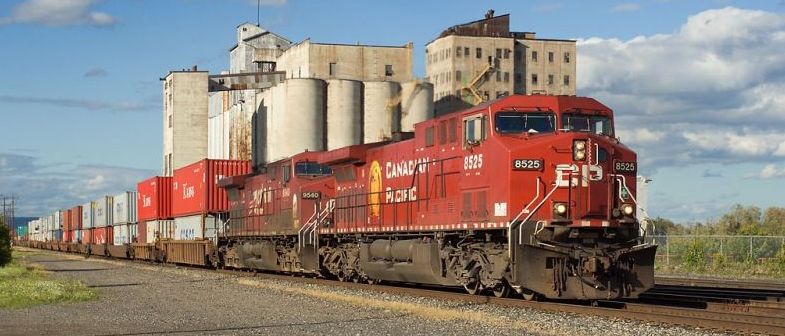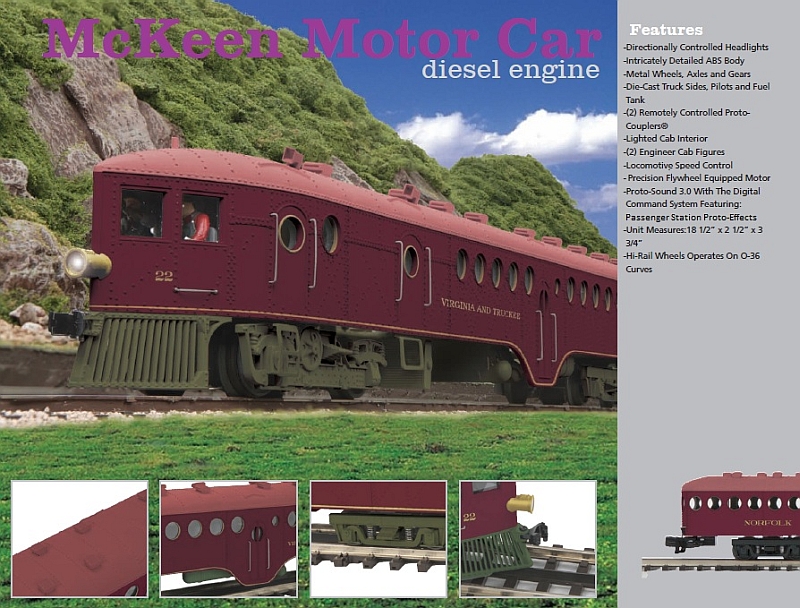
Train Addiction Help Line: 1.866.840.7777
Oct 8, 2011 - O Scale
ORDER DEADLINE ALERT - MTH (Premier) McKeen Motor Cars
You must place an order for any of these products NOW if you want GUARANTEED DELIVERY.




With its knife-edged prow, steel body, and porthole windows, the McKeen Car looked more like a nautical Jules Verne creation than a railroad car. No wonder, because the McKeen Car had its origins in a torpedo boat. At the dawn of the twentieth century, Edward H. Harriman, President of the Union Pacific (U.P.) and Southern Pacific (S.P.) railroads, was impressed with the U.S. Navy's experiments with high-speed torpedo boats. He wondered if their lightweight, powerful internal combustion engines could address an age-old railroad problem: providing economical passenger service on lightly traveled routes. To realize his idea, Harriman turned to William R. McKeen, Jr., the U.P.'s young, college-educated superintendent of motive power.
Like Harriman, McKeen was imaginative and forward-thinking, and the resulting product employed cutting edge and experimental technologies. Built in the U.P.'s Omaha shops from 1904-1917, McKeen Motor Car Company vehicles used roller bearings and had all-steel bodies at the very dawn of the steel car age. Their aerodynamic shape was called a "wind splitter," as the word "streamlined" was not yet in common use. (In fact, the streamlining was of little use at the cars' top speed of 50 mph, and later experiments would show the cars' shape was actually more streamlined in reverse.) Crash protection would prove to be an unintended side benefit of the pointed prow, which collapsed in front-end collisions and protected the occupants, much like today's automobiles. To modern observers, the view of the world through the McKeens' massive portholes recalls the Beatles' Yellow Submarine.
The 150 or so McKeen Cars were also America's first mass-produced internal combustion rail vehicles. Like today's O gauge diesels, the cars had a truck-mounted motor that swiveled with the front truck. To back up, the motorman had to stop the engine, shift the camshaft, and restart the engine in reverse. Starting was by compressed air stored in the cars' tanks and replenished while running; many a McKeen had to be push-started when the air ran out.
Not surprisingly, the Harriman-ruled U.P. and S.P. were McKeen's biggest customers, while a large number of roads nationwide bought a unit or two to try out. But the McKeen motor and transmission proved somewhat unreliable and, perhaps more important, railroads were not yet ready to embrace internal combustion power; both McKeen and its keenest rival, General Electric, ended production of internal combustion cars in 1917.
New for 2011, M.T.H. introduces our Premier model of this odd, endearing, futuristic car, decorated for four of the original purchasers: Union Pacific, Pennsylvania (which later sold its 1910 car to the Illinois Central), Norfolk & Southern Railway (the namesake of today's Norfolk Southern), and the Virginia and Truckee, whose Car No. 22 is just returning to operation after decades as a diner and storage building, capping a 13-year restoration by the Nevada State Railroad Museum.
ORDER BY OCTOBER 15, 2011 FOR DELIVERY IN JANUARY 2012
jkb










